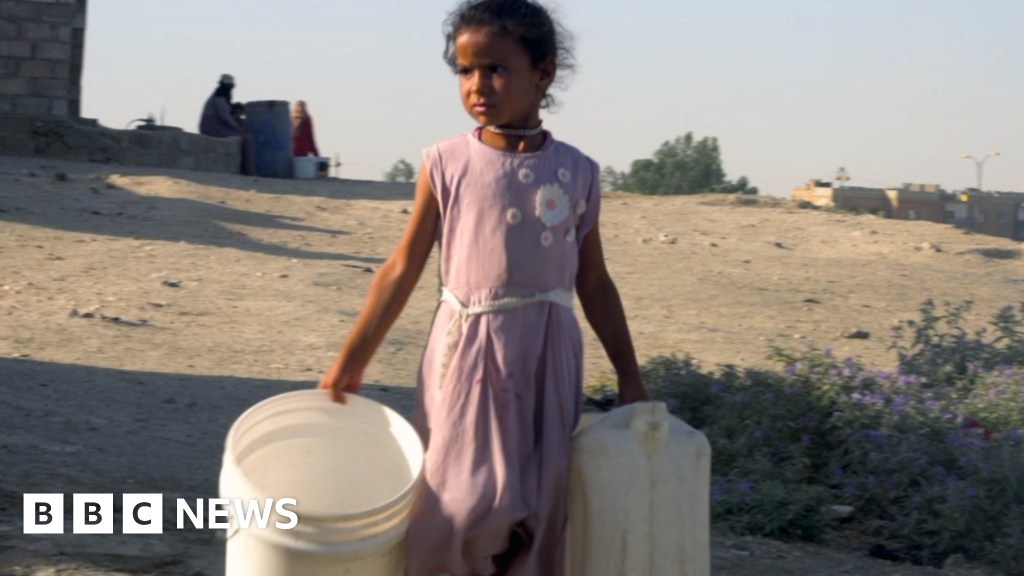ARTICLE AD BOX
By Janhavee Moole
BBC Marathi

A month after heavy floods swept Gadchiroli district, its residents are yet to return to their homes
"It's been over a month of living with nothing," Neelakka Modem, a tribal woman from the western Indian state of Maharashtra, says gloomily as rain trickles down her rickety plastic tent.
She and her family, along with 700 others, were forced to abandon their homes in Somanpalli village in Gadchiroli district after heavy rains in July triggered massive floods. They have been camping along a national highway ever since.
"The authorities came in the middle of the night and asked us to move to safety. We left with nothing but the clothes we were wearing," Ms Modem, 70, recalled.
The state government has provided food and water, but living by the highway carries risks - speeding vehicles, wild animals, including deadly snakes, are common in this region which is home to dense tropical forests.
Back in the village, Ms Modem's son Madhukar, a farm labourer, is trying to salvage whatever he can from their destroyed house. But Ms Modem wonders if they will ever go back.
"We can't live there anymore - the place is inhabitable. The government should rehabilitate us elsewhere," she said.
Residents of Somanpalli village in Gadchiroli have been living in camps along a highway
Heavy rainfall is common during the monsoon in Gadchiroli district, which is surrounded by forests. Here, the Godavari river, the second longest in India, along with its tributaries, forms a flood-prone zone between June and September. During those months, if often overflows and enters the villages.
But residents say the flooding has become worse in recent years.
Torrential rains this year between 11 July and 19 July left a trail of devastation- at least 34 of the 52 towns and villages along the riverbank in Gadchiroli were submerged for days, while three of them, including Somanpalli, were almost wiped out as water levels rose to their highest point in 35 years.
The rains have stopped now, but people are yet to return home or start rebuilding their lives.
"I've never seen a flood like this. This time, it has taken everything," Ms Modem said.
Image source, ANI
Image caption,The lush region of Gadchiroli receives heavy rainfall every year
Villagers and environmental experts say the heavy floods are caused by the discharge of water from a nearby dam in Medigadda - a village in the neighbouring state of Telangana. But authorities have denied the claim.
"The dam has no effect on the flood situation in Gadchiroli and its neighbouring areas. In fact, because of the construction of flood banks, heavy damages could be avoided during the recent floods," said Dr Rajat Kumar, a senior official in Telangana's irrigation department.
Mr Kumar added that irrigation officials in his state were "continuously coordinating" with their counterparts in Maharashtra over the situation.
The dam, known as Lakshmi Barrage, is located on the border between Maharashtra and Telangana. It was constructed in 2016 after the two states signed a water-sharing agreement.
Since its inception, the project has been embroiled in controversies over the alleged violation of environment laws - a claim denied by both state governments.
"People had opposed construction of this dam and there were protests, but the government of Maharashtra and Telangana did not pay any heed - now, we are suffering because of that," said Ranjit Gagapurwar, a local social activist.
He added that villagers who live on the banks of the Godavari river needed to be relocated permanently because "it will flood every monsoon".
Jitendra Shiktode, a government officer in Maharashtra who is in charge of Gadchiroli, said: "We are trying hard to help the villagers. But it's not possible to relocate them so quickly."
Environmental experts say that the intensity of floods in the region has increased over the years
Experts, however, say that the issue is not just about rehabilitation, but about the management of hydro projects.
"Every dam is a potential source of disaster. That's the reality and one needs to be aware of it," says Himanshu Thakkar, an environmental activist and water expert, who is also the coordinator of South Asia Network on Dams, Rivers and People (SANDRP).
"It's not just that the dam could break, but also if it is not operated properly, it could lead to floods."
On 8 August, India's ministry of water resources had acknowledged that "faulty operations of reservoirs may sometimes result in flooding of downstream regions."
Mr Thakkar explained how this could happen: "India has concentrated rainfall in three-four months of monsoon. So if a dam is filled right at the beginning of the season and it rains further, authorities end up releasing water from the dam while the area downstream is already flooded, worsening the situation."
One of the things to ensure proper operation of dams is a "rule curve" or a graph that shows when and how a dam is to be filled gradually through the season.
This graph, Mr Thakkar explained, must be designed considering the siltation and carrying capacity of the downstream river, or the tide timings, if the dam is close to the coast.
Residents say that a dam located in the neighbouring state of Telangana is responsible for the floods
Besides, authorities also need to regularly update the curve to accommodate changes in rainfall patterns. "Increasingly we are witnessing late monsoons. So we need to change the rules accordingly," he said.
This is extremely important for regions like South Asia, where extreme weather events like floods are expected to become more frequent amid rising temperatures, according to a 2022 report by the Intergovernmental Panel on Climate Change (IPCC).
Back in Somanpalli, water levels have reduced. But villagers are still living by the highway.
They fear another deluge since the monsoon is not over yet.
"What's the point in going back? We have lost everything," Ms Modem said.
Additional reporting by Sumit Pakalwar in Telangana

 2 years ago
43
2 years ago
43








 English (US)
English (US)